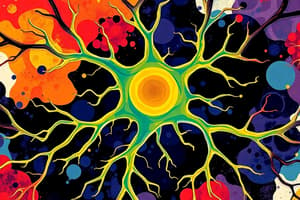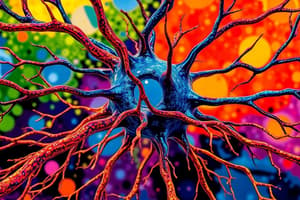Podcast
Questions and Answers
What is the primary role of a neuron in the nervous system?
What is the primary role of a neuron in the nervous system?
- To generate electrical impulses and transmit signals (correct)
- To support and protect other cells
- To transport nutrients throughout the nervous system
- To produce energy for other cell types
Which part of the neuron is primarily responsible for receiving signals?
Which part of the neuron is primarily responsible for receiving signals?
- Dendrites (correct)
- Axon terminal
- Axon
- Myelin sheath
The axon terminal is essential for what function in neurons?
The axon terminal is essential for what function in neurons?
- Focusing incoming signals
- Generating electrical signals
- Releasing neurotransmitters (correct)
- Enhancing the metabolic activity
What is the role of the myelin sheath in the nervous system?
What is the role of the myelin sheath in the nervous system?
Which type of cell forms the myelin sheath in the peripheral nervous system?
Which type of cell forms the myelin sheath in the peripheral nervous system?
What initiates the generation of electrical signals in most neurons?
What initiates the generation of electrical signals in most neurons?
How do neurons integrate information from other neurons?
How do neurons integrate information from other neurons?
Which component of the neuron is primarily responsible for energy production and metabolic support?
Which component of the neuron is primarily responsible for energy production and metabolic support?
What structures house the Central Nervous System?
What structures house the Central Nervous System?
Which part of the nervous system consists of 12 pairs of cranial nerves?
Which part of the nervous system consists of 12 pairs of cranial nerves?
What type of neurons are responsible for transmitting impulses from the periphery to the CNS?
What type of neurons are responsible for transmitting impulses from the periphery to the CNS?
Which division of the nervous system controls voluntary functions of the body?
Which division of the nervous system controls voluntary functions of the body?
Which route do motor (efferent) pathways primarily take?
Which route do motor (efferent) pathways primarily take?
What is the primary function of the autonomic nervous system?
What is the primary function of the autonomic nervous system?
Which of the following is NOT a characteristic of sensory neurons?
Which of the following is NOT a characteristic of sensory neurons?
Which nerve fibers are part of the peripheral nervous system?
Which nerve fibers are part of the peripheral nervous system?
What is the primary function of efferent neurons?
What is the primary function of efferent neurons?
Which statement about interneurons is correct?
Which statement about interneurons is correct?
What characterizes the structure of a neuron that has an unusual shape?
What characterizes the structure of a neuron that has an unusual shape?
Where are most of the axons of efferent neurons located?
Where are most of the axons of efferent neurons located?
What happens to the signal when an excitatory input is processed by an interneuron?
What happens to the signal when an excitatory input is processed by an interneuron?
What primary role does the myelin sheath serve for axons?
What primary role does the myelin sheath serve for axons?
What is the role of nodes of Ranvier in myelinated axons?
What is the role of nodes of Ranvier in myelinated axons?
Which cells are responsible for forming the myelin sheath in the central nervous system?
Which cells are responsible for forming the myelin sheath in the central nervous system?
How do Schwann cells differ from oligodendrocytes in their role in myelination?
How do Schwann cells differ from oligodendrocytes in their role in myelination?
Which of the following statements is true concerning microglia?
Which of the following statements is true concerning microglia?
What is the primary composition of the myelin sheath?
What is the primary composition of the myelin sheath?
What function do astrocytes serve in the central nervous system?
What function do astrocytes serve in the central nervous system?
What differentiates unmyelinated axons from myelinated axons?
What differentiates unmyelinated axons from myelinated axons?
Flashcards
Neurons
Neurons
Fundamental units of the nervous system that generate and transmit electrical signals.
Glial cells
Glial cells
Support cells that surround and support neurons physically and metabolically.
Cell body (soma)
Cell body (soma)
The part of the neuron containing the nucleus and other vital organelles.
Dendrites
Dendrites
Branched structures that receive input from other neurons.
Signup and view all the flashcards
Axon
Axon
A long, slender fiber that transmits signals away from the cell body.
Signup and view all the flashcards
Axon hillock
Axon hillock
The junction between the axon and cell body, where electrical signals are generated.
Signup and view all the flashcards
Axon terminal
Axon terminal
The end of the axon branches, responsible for releasing neurotransmitters.
Signup and view all the flashcards
Myelin sheath
Myelin sheath
A protective sheath that insulates axons, enabling rapid signal conduction.
Signup and view all the flashcards
Nodes of Ranvier
Nodes of Ranvier
Gaps in the myelin sheath that allow for rapid signal conduction.
Signup and view all the flashcards
Schwann cells
Schwann cells
Cells that produce the myelin sheath in the peripheral nervous system.
Signup and view all the flashcards
Oligodendrocytes
Oligodendrocytes
Cells that produce the myelin sheath in the central nervous system.
Signup and view all the flashcards
Astrocytes
Astrocytes
The type of glial cell that regulates extracellular fluid, contributes to the blood-brain barrier, and provides metabolic support to neurons.
Signup and view all the flashcards
Microglia
Microglia
The type of glial cell that acts as scavenger cells, removing cellular debris and mediating inflammatory responses.
Signup and view all the flashcards
Central nervous system (CNS)
Central nervous system (CNS)
The part of the nervous system consisting of the brain and spinal cord.
Signup and view all the flashcards
Peripheral nervous system (PNS)
Peripheral nervous system (PNS)
The part of the nervous system consisting of nerves that extend from the CNS to the rest of the body.
Signup and view all the flashcards
Cranial nerves
Cranial nerves
Nerves that originate from the brain.
Signup and view all the flashcards
Spinal nerves
Spinal nerves
Nerves that originate from the spinal cord.
Signup and view all the flashcards
Afferent (sensory) neurons
Afferent (sensory) neurons
Neurons that convey information from sensory receptors to the CNS.
Signup and view all the flashcards
Efferent (motor) neurons
Efferent (motor) neurons
Neurons that transmit signals from the CNS to effectors.
Signup and view all the flashcards
Interneurons
Interneurons
Neurons located entirely within the CNS, connecting sensory and motor neurons.
Signup and view all the flashcards
Neural integration
Neural integration
The process by which neurons integrate multiple inputs to determine their output.
Signup and view all the flashcards
Synapse
Synapse
A synapse that allows signals to be transmitted from one neuron to another.
Signup and view all the flashcards
Neurotransmitters
Neurotransmitters
Chemical messengers that transmit signals across synapses.
Signup and view all the flashcards
Neurotransmitter release
Neurotransmitter release
The process by which neurons release neurotransmitters into the synaptic cleft.
Signup and view all the flashcards
Neurotransmitter binding
Neurotransmitter binding
The process by which neurotransmitters bind to receptors on the postsynaptic membrane.
Signup and view all the flashcards
Neurotransmitter reuptake
Neurotransmitter reuptake
The process by which neurotransmitters are removed from the synaptic cleft.
Signup and view all the flashcards
Resting membrane potential
Resting membrane potential
The resting potential of a neuron, typically around -70 mV.
Signup and view all the flashcards
Action potential
Action potential
A brief, rapid, and reversible change in the membrane potential of a neuron.
Signup and view all the flashcards
Threshold potential
Threshold potential
The threshold potential that must be reached to trigger an action potential.
Signup and view all the flashcards
Refractory period
Refractory period
The period of time during which a neuron cannot generate another action potential.
Signup and view all the flashcardsStudy Notes
Introduction
- The nervous system is formed from two type of cells: neurons and glial cells.
- Neurons are the fundamental units of the nervous system, responsible for generating and transmitting electrical signals throughout the body.
- Neurons function as integrators: their output is determined by the combined input received from numerous other neurons.
Neuron Structure
- Neurons exhibit a diverse range of shapes and sizes, but they share common features.
- Each neuron possesses a cell body, dendrites, an axon, and an axon terminal.
- The cell body (soma) contains the nucleus, ribosomes, mitochondria, and other essential organelles.
- Dendrites are branched structures that receive input from other neurons and convey signals towards the cell body.
- The axon, or nerve fiber, transmits signals away from the cell body.
- The axon hillock, located at the junction of the axon and cell body, acts as the trigger zone for electrical signal generation.
- The axon terminal, at the end of axon branches, is responsible for releasing neurotransmitters, which communicate with the next neuron or target cell.
Myelin Sheath
- Most neurons are coated by a protective myelin sheath.
- The myelin sheath insulates axons, preventing cross-stimulation between adjacent axons.
- It enables rapid conduction of nerve impulses, facilitating "jumping" of signals from one node of Ranvier to the next.
- The myelin sheath is formed by Schwann cells in the peripheral nervous system (PNS) and oligodendrocytes in the central nervous system (CNS).
- Schwann cells wrap tightly around axons, forming layers of plasma membrane.
- Each Schwann cell covers a segment of the axon, separated by unmyelinated gaps called nodes of Ranvier.
- Oligodendrocytes, unlike Schwann cells, can myelinate multiple axons.
Glial Cells
- Glial cells, also known as supporting cells, surround and support neurons physically and metabolically.
- They constitute a majority of the cells in the central nervous system.
- Three major types of glial cells exist:
- Astrocytes: regulate extracellular fluid composition, contribute to the blood-brain barrier, and provide metabolic support to neurons.
- Microglia: act as scavenger cells, removing cellular debris and mediating inflammatory responses.
- Oligodendrocytes: form myelin sheaths in the CNS.
Anatomical Organization of the Nervous System
- The nervous system is divided into two main parts: the central nervous system (CNS) and the peripheral nervous system (PNS).
- The CNS comprises the brain and spinal cord, which are protected by bony structures: the skull and vertebral column.
- The PNS consists of nerves that extend between the CNS and other parts of the body, including muscles, glands, and sensory receptors.
- The PNS is further divided into cranial nerves, which originate from the brain, and spinal nerves, which originate from the spinal cord.
Functional Organization of the Nervous System
- Functionally, neurons are categorized into three main types:
- Afferent (sensory) neurons: convey information from sensory receptors to the CNS.
- Efferent (motor) neurons: transmit signals from the CNS to effectors, such as muscles and glands.
- Interneurons: located entirely within the CNS, they connect sensory and motor neurons, acting as neuronal bridges, and can modify signal strength or type.
Studying That Suits You
Use AI to generate personalized quizzes and flashcards to suit your learning preferences.




